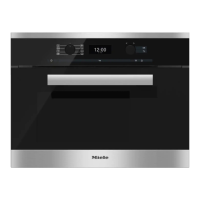Special applications
77
Make yoghurt
To make yoghurt, you will need either
fr
esh live yoghurt or yoghurt culture,
obtainable from health food shops.
Use natural yoghurt with live culture
and without additives. Heat-tr
eated yo‐
ghurt is not suitable.
The yoghurt must be fresh (short stor‐
age time)
You can use either unchilled long-life or
fr
esh milk.
Long-life milk can be used without any
further treatment. Fresh milk must first
be heated to 90 °C and then cooled
down to 35 °C. Do not boil it. Fresh milk
will give a better set than long-life milk.
The yoghurt and milk should have the
same per
centage fat.
Do not move or shake the jars whilst
the yogh
urt is thickening.
Immediately after preparation leave the
yogh
urt to cool in the fridge.
How well home prepared yoghurt sets
will depend on the consi
stency, fat con‐
tent and the cultures used in the starter
yogurt. Not all yoghurts are suitable for
use as starter yoghurt.
Possible reasons for unsatisfactory
r
esults
Yoghurt has not set:
Incorr
ect storage of starter yoghurt, too
much time out of the refrigerator, e.g. in
transportation, damaged packaging,
milk not sufficiently heated.
Liquid has separated:
The ja
rs were moved, yoghurt was not
cooled down quickly enough.
Yoghurt is gritty:
Milk was overh
eated or in poor condi‐
tion, milk and starter yoghurt not evenly
stirred.
Tip: When usi
ng yoghurt enzyme, yo‐
ghurt can be made from a milk / cream
mixture. Mix ³/₄ litre milk with ¹/₄ litre
cream.

